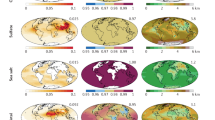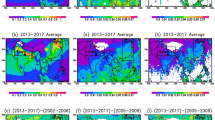Abstract
Aerosols both scatter and absorb incoming solar radiation, with consequences for the energy balance of the atmosphere. Unlike greenhouse gases, atmospheric aerosols are distributed non-uniformly around the Earth. Therefore, regional shifts in aerosol abundance could alter radiative forcing of the climate. Here, I use multi-angle imaging spectroradiometer (MISR) satellite data and the Atmospheric and Environmental Research radiative transfer model1 to assess the radiative effect of the spatial redistribution of aerosols over the past decade. Unexpectedly, the radiative transfer model shows that the movement of aerosols from high latitudes towards the Equator, as might happen if pollution shifts from Europe to southeast Asia, has little effect on clear-sky radiative forcing. Shorter slant paths and smaller upscatter fractions near the Equator compensate for more total sunlight there. Overall, there has been an almost exact cancellation in the clear-sky radiative forcing from aerosol increases and decreases in different parts of the world, whereas MISR should have been able to easily detect a change of 0.1 W m−2 per decade due to changing patterns. Long-term changes in global mean aerosol optical depth or indirect aerosol forcing of clouds are difficult to measure from satellites. However, the satellite data show that the regional redistribution of aerosols had little direct net effect on global average clear-sky radiative forcing from 2000 to 2012.
This is a preview of subscription content, access via your institution
Access options
Subscribe to this journal
Receive 12 print issues and online access
$259.00 per year
only $21.58 per issue
Buy this article
- Purchase on Springer Link
- Instant access to full article PDF
Prices may be subject to local taxes which are calculated during checkout




Similar content being viewed by others
References
Clough, S. A. et al. Atmospheric radiative transfer modeling: a summary of the AER codes, Short Communication. J. Quantum. Spectrosc. Radiat. Transf. 91, 233–244 (2005).
Mishchenko, M. I. & Geogdzhayev, I. V. Satellite remote sensing reveals regional tropospheric aerosol trends. Opt. Express 15, 7423–7438 (2007).
Zhao, T. X-P. et al. Study of long-term trend in aerosol optical thickness observed from operational AVHRR satellite instrument. J. Geophys. Res. 113, D07201 (2008).
Zhao, T. X-P., Heidinger, A. K. & Knapp, K. R. Long-term trends of zonally averaged aerosol optical thickness observed from operational satellite AVHRR instrument. Meterol. Appl. 18, 440–445 (2011).
Deshler, T., Hervig, M. E., Hofnn, D. J., Rosen, J. M. & Liley, J. B. Thirty years of in situ stratospheric aerosol size distribution measurements from Laramie, Wyoming (41 N), using balloon-borne instruments. J. Geophys. Res. 108, 4167 (2003).
Zhang, J. & Reid, J. S. A decadal regional and global trend analysis of the aerosol optical depth using a data-assimilation grade over-water MODIS and Level 2 MISR aerosol products. Atmos. Chem. Phys. 10, 10949–10963 (2010).
Hsu, N. C. et al. Global and regional trends of aerosol optical depth over land and ocean using SeaWiFS measurements from 1997 to 2010. Atmos. Chem. Phys. 12, 8037–8053 (2012).
Diner, D. J. et al. The value of multiangle measurements for retrieving structurally and radiatively consistent properties of clouds, aerosols, and surfaces. Remote Sens. Environ. 97, 495–518 (2005).
Martonchik, J. V., Kahn, R. A. & Diner, D. J. in Satellite Aerosol Remote Sensing Over Land (eds Kokhanovsky, A. A. & de Leeuw, G.) 267–293 (Springer, 2009).
Yu, H. et al. Direct radiative effect of aerosols as determined from a combination of MODIS retrievals and GOCART simulations. J. Geophys. Res. 109, D03206 (2004).
Zhou, M., Yu, H., Dickinson, R. E., Dubovik, O. & Holben, B. N. A normalized description of the direct effect of key aerosol types on solar radiation as estimated from Aerosol Robotic Network aerosols and Moderate Resolution Imaging Spectroradiometer albedos. J. Geophys. Res. 110, D19202 (2005).
McComiskey, A. et al. Direct aerosol forcing: Calculation from observables and sensitivities to inputs. J. Geophys. Res. 113, D09202 (2008).
Chen, Y., Li, Q., Kahn, R. A., Randerson, J. T. & Diner, D. J. Quantifying aerosol direct radiative effect with Multiangle Imaging Spectroradiometer observations: Top-of-atmosphere albedo change by aerosols based on land surface types. J. Geophys. Res. 114, D02109 (2009).
Meija, A. d., Pozzera, A. & Lelieveld, J. Trend analysis in aerosol optical depths and pollutant emission estimates between 2000 and 2009. Atmos. Environ. 51, 75–85 (2012).
Menzel, W. P. et al. MODIS global cloud-top pressure and amount estimation: Algorithm description and results. J. Appl. Meteorol. Clim. 47, 1175–1198 (2008).
Li, Z. et al. Uncertainties in satellite remote sensing of aerosols and impact on monitoring its long-term trend: a review and perspective. Ann. Geophys. 27, 2755–2770 (2009).
Kahn, R. A. et al. Multiangle Imaging SpectroRadiometer global aerosol product assessment by comparison with the Aerosol Robotic Network. J. Geophys. Res. 115, D23209 (2010).
Kahn, R. A. Reducing the uncertainties in direct aerosol radiative forcing. Surv. Geophys. 33, 701–721 (2012).
Granier, C. et al. Evolution of anthropogenic and biomass burning emissions of air pollutants at global and regional scales during the 1980–2010 period. Climatic Change 109, 163–190 (2011).
Pozzoli, L. et al. Re-analysis of tropospheric sulfate aerosol and ozone for the period 1980–2005 using the aerosol-chemistry-climate model ECHAM5-HAMMOZ. Atmos. Chem. Phys. 11, 9563–9594 (2011).
Bellouin, N. et al. Aerosol forcing in the Climate Model Intercomparison Project (CMIP5) simulations by HadGEM2—ES and the role of ammonium nitrate. J. Geophys. Res. 116, D20206 (2012).
Sorooshian, A., Feingold, G., Lebsock, M. D., Jiang, H. & Stephens, G. L. On the precipitation susceptibility of clouds to aerosol perturbations. Geophys. Res. Lett. 36, L13803 (2009).
Jin, Z., Charlock, T. P. Jr & Rutledge, W. L. S. A parameterization of ocean surface albedo. Geophys. Res. Lett. 31, L22301 (2004).
Acknowledgements
This work was financially supported by NOAA base and climate-change funding. I thank R. Kahn, J. Daniel and A. McComiskey for helpful comments.
Author information
Authors and Affiliations
Corresponding author
Ethics declarations
Competing interests
The author declares no competing financial interests.
Supplementary information
Supplementary Information
Supplementary Information (PDF 1653 kb)
Rights and permissions
About this article
Cite this article
Murphy, D. Little net clear-sky radiative forcing from recent regional redistribution of aerosols. Nature Geosci 6, 258–262 (2013). https://doi.org/10.1038/ngeo1740
Received:
Accepted:
Published:
Issue Date:
DOI: https://doi.org/10.1038/ngeo1740
This article is cited by
-
Role of volcanic and anthropogenic aerosols in the recent global surface warming slowdown
Nature Climate Change (2016)
-
Distinct energy budgets for anthropogenic and natural changes during global warming hiatus
Nature Geoscience (2016)
-
Declining uncertainty in transient climate response as CO2 forcing dominates future climate change
Nature Geoscience (2015)
-
Air pollution or global warming: Attribution of extreme precipitation changes in eastern China—Comments on “Trends of extreme precipitation in Eastern China and their possible causes”
Advances in Atmospheric Sciences (2015)



